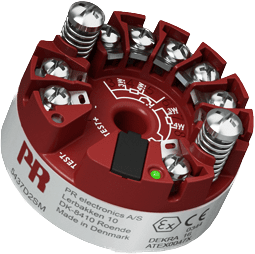Description
- RTD, TC, potentiometer, linear resistance and bipolar mV input
- Single or true dual inputs with sensor redundancy and drift detection
- Wide ambient operating temperature of -50 to +85° C
- Total accuracy from 0.014%
- 2.5 kVAC galvanic isolation
- Full assessment to IEC61508 : 2010 up to SIL 2/3
- True dual input transmitter. High density 7-terminal design accepts the widest range of dual input combinations.
- Sensor redundancy - output automatically switches to secondary sensor in event of primary sensor failure, maintaining uptime.
- Sensor drift detection - alerts when sensor differential exceeds user-defined limits, for maintenance optimization.
- Dynamic variable mapping for process data in addition to the primary variable e.g. dual input features such as average, differential and min./max. tracking.
- Groundbreaking digital and analog signal accuracy over full input span and ambient conditions.
- Extensive sensor matching including Callendar Van Dusen and custom linearizations.
- Programmable input limits with runtime metering ensure maximum process traceability and sensor out of range protection.
- IEC 61508 : 2010 full assessment up to SIL 3 together with enhanced EMC Functional Safety testing to IEC 61236-3-1.
- Meets NAMUR NE21, NE43, NE44, NE89, NE95 and NE107 compliant diagnostics information.
Configure
Specifications
Specifications
Brand
Approvals & Certifications
- ATEX DEKRA 16ATEX0047X
- EAC TR-CU 020/2011
- EMC 2014/30/EU
- RoHS 2011/65/EU
- NAMUR NE95 Report
- SIL 2 / SIL 3 Certified & Fully Assessed acc. to IEC 61508
- EU RO MR Type Approval, MRA0000023
- EAC Ex RU C-DK.GB.98.V.00192
- NEPSI GYJ18.1054X
- INMETRO DEKRA 16.0008 X
- cFMus FM16US0287X / FM16CA0146X
- CSA 16.70066266
- IECEx dEK. 16.0029X
Environmental Protection
- IP68 / IP00
Response Time
- 70 milliseconds
Supply Voltage
- 7.5-30 Vdc
Operating Temperature
- -40° to 80° C (SIL)
- -50° to 85° C (Standard)
Storage Temperature
- -50° to 85° C
Calibration Temperature
- 23° to 25° C
Humidity
- < 99 % Relative Humidity, Non-Condensing
Vibration
- ± 1.6 mm at 2 to 25 Hz
- ± 4 g at 25 to 100 Hz
RTD Type
- Pt10...10000, Ni10...10000, Cu5...1000
Output
- Normal Range, Programmable: 3.8-20.5 / 20.5-3.8 mA
- Extended Range, (Output Limits) Programmable: 3.5-23 / 23-3.5 mA
Output Signal
- 4-20 mA
Applications
Applications
- Temperature measurement of a wide range of TC and RTD types.
- Conversion of wide span linear resistance and potentiometer inputs.
- Conversion of bipolar mV signals to 4...20 mA.
- Integration into asset management schemes.
- Critical applications requiring superior accuracy and/or sensor redundancy and drift detection.
Documentation
Documentation
Product Manuals
Certifications
- ATEX Certificate pdf 330 KB
- CCC Statement pdf 76 KB
- CSA Certificate pdf 332 KB
- DNV Marine Certificate pdf 74 KB
- DTM Certificate pdf 115 KB
- EAC Declaration pdf 355 KB
- EAC Ex Certificate pdf 6.0 MB
- EU Declaration of Conformity pdf 118 KB
- FM Certificate pdf 449 KB
- HART Certificate pdf 140 KB
- IECEx Certificate pdf 278 KB
- INMETRO Certificate pdf 2.4 MB
- Metrology Pattern Approval (MPA) pdf 7.2 MB
- NEPSI Certificate pdf 5.9 MB
- SIL Certificate pdf 325 KB
